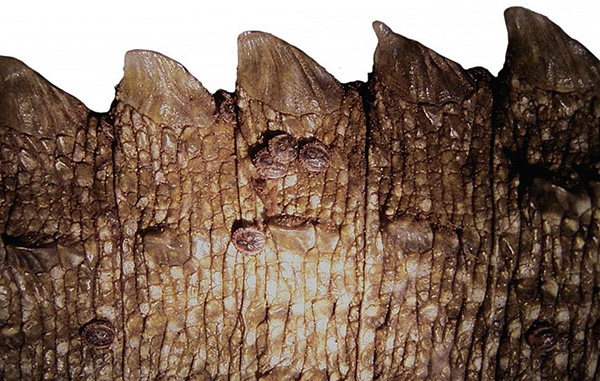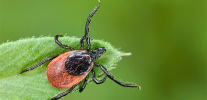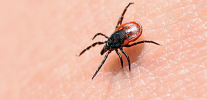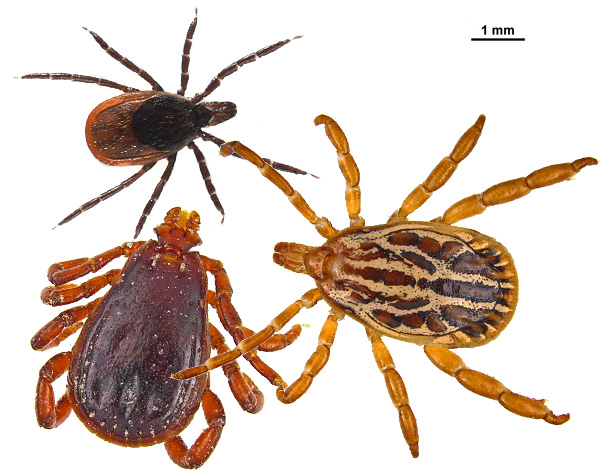
Ixodid ticks (Ixodidae) are one of the most famous human parasites and, perhaps, the most recognizable among all their relatives. And at first glance it may seem that there are not so many reasons for such fame.
Ixodides are not the largest group in the subclass: there are only about 900 species among the 54,000 species of ticks in general. They do not have as much economic value as other types of ticks, for example, spiderweeds, leading to huge crop losses in different countries. Yes, and because of their epidemiological significance, ixodides are inferior to their other relatives - dust mites, causing millions of asthma cases all over the world, scabies for itching (scabies pathogens) and acne sites parasitizing literally on every adult person on the planet.
Nevertheless, ixodic ticks are well known and strongly feared, primarily because of their ability to infect humans with deadly infections that are relevant not only in the taiga, but also within cities.Tick-borne encephalitis and Borreliosis of Lyme are transmitted by parasites every year, hundreds of people around the world die and become disabled, and many pets die from veterinary infections.
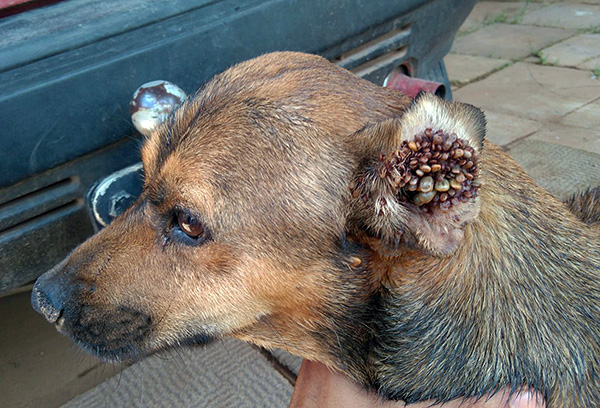
But besides the epidemiological significance, Ixodes ticks are very interesting due to the unique features of their biology and interaction with their owners. Many of these nuances, we will continue to look at more ...
Representatives of the family
The family Ixodidae, despite the relatively small number of species within it, is characterized by a significant diversity of its representatives both in appearance and (to a greater extent) in lifestyle.
One of the most typical and well-known representatives is the taiga tick Ixodes persulcatus, which lives mainly in the northeastern regions of Russia and is the carrier of spring-summer tick-borne encephalitis. With the onset of the warm season, the nymphs, after wintering in the forest floor, begin to hunt small mammals and reptiles, and adult imagoes are looking for food for large animals (or humans).
The photo below shows adult representatives of this species:

Another, similar species - Ixodes ricinus, or dog tick - is more typical for the European zone. It is found in deciduous and mixed forests, active mainly in spring and autumn. His imago is parasitic on livestock, dogs, hares and humans. It is these ticks that are responsible for infecting the so-called western form of encephalitis and Lyme borreliosis in Europe.
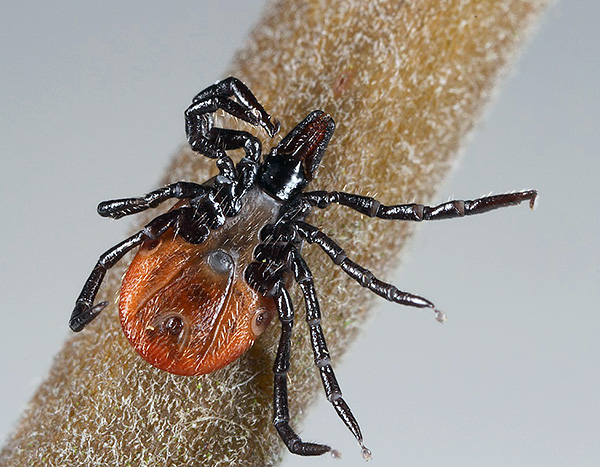
Ixodide species from the genus Dermacentor, recognizable by the white enamel pattern on the dorsal scute and also living in Europe and the European part of Russia, are the main carriers of tularemia and tick-borne typhus:
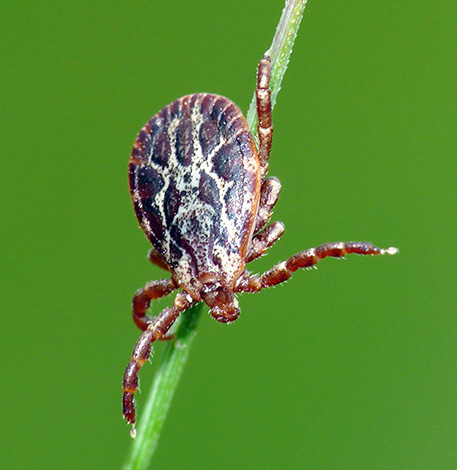
On the Black Sea and Caspian coasts a brown dog tick is spread that can endure Marseilles spotted fever. At each stage of development, such a tick feeds only on dogs; however, a person can become infected if he crushes a tick and then itself infects the mucous membranes of the mouth, eyes or nose.
Photo of a brown dog tick:
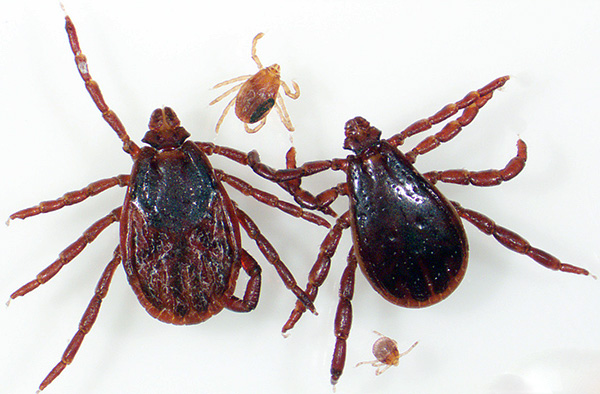
Some other ixodides are interesting but less familiar to the general public:
- Mite Ixodes holocyclus - lives exclusively on the east coast of Australia. It has an interesting feature - the high toxicity of saliva secreted into the wound during sucking. His neurotoxin is so strong that it can lead to paralysis and death of victims - kangaroos, koalas, dogs and even humans.;
- The mite Ixodes uriae is a dweller of the lowest latitudes among all Ixodes. Its typical owners are birds nesting on the Arctic and Antarctic islands, as well as on the continental coasts of the Arctic and Antarctic. Because of the very short nesting period of the host birds, most of the year these ticks go hungry, just waiting in the wings, hiding in crevices of rocks, burrows and old nests on the coasts;
- Camel tick Hyalomma dromedarii is one of the most common in North Africa, and therefore tourists in Egypt may well encounter it. The main preferred owners are camels, but hungry individuals do not disdain other animals. A person usually develops necrosis around the bite site, but with proper treatment, he, fortunately, heals relatively quickly;
- Ixodes lividus is a specific parasite of coastal swallows living right in their nests. Its life cycle is closely related to that of the host birds: ticks are actively nourished with blood in the spring and summer, and they are starving throughout autumn and winter and patiently wait for the return of their hosts in their own nests;
- Representatives of tropical species Amblyomma are ixodid ticks, characterized by large size and phenomenal fecundity. A female who has sucked blood can reach the size of a plum, and is able to lay up to 30 thousand eggs.
The photo below shows the pork mite Amblyomma sculptum:
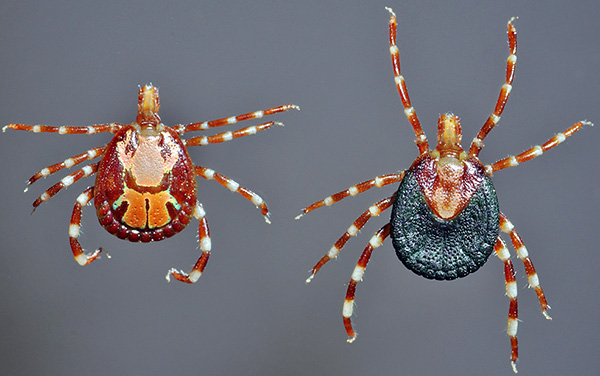
On a note
Due to the fact that most ixodides parasitize on a wide range of hosts, scientists still argue about their origin and evolutionary relationships within the family. Some believe that the primary ixodid ticks were reptilian parasites, and only then began to migrate to mammals. Others assure the opposite - that mammals were the first owners of ixodides.
Today, the family is systematically divided into two groups, one of which includes, in fact, the genus Ixodes, and the other includes all the others. But the lack of data on fossil species still leaves open the question of the taxonomy of the group of ixodid ticks.
Appearance and anatomical features of ixodic ticks
The appearance of ixodic ticks is quite recognizable. Adult representatives of most species in the hungry state reach sizes of about 5 mm, and their body is strongly flattened in the dorso-ventral direction.
In the structure of the parasite, the gnatosome is isolated - the “head”, which is actually a complex oral apparatus, as well as an idiosome — the body itself, to which 4 pairs of legs are attached. This detail of the description is very important, and helps to distinguish the parasite from other arthropods in appearance.
The photo below shows the gnathosome of the fed female:
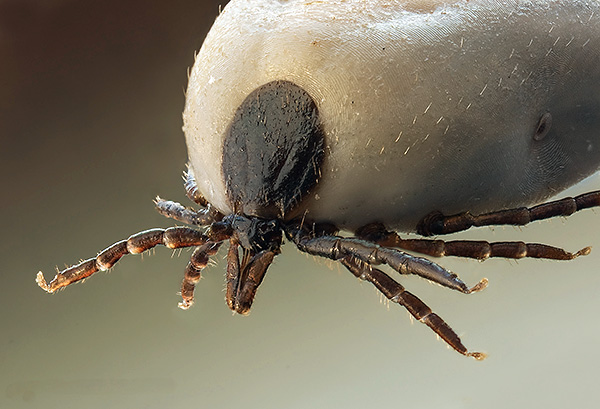
Ixodic ticks have olfactory organs on their paws, and therefore they usually wait for their prey by pushing them forward. There are also many bristles on the body and legs, which help to stay on different surfaces, serve as an element of protection and help in settling.
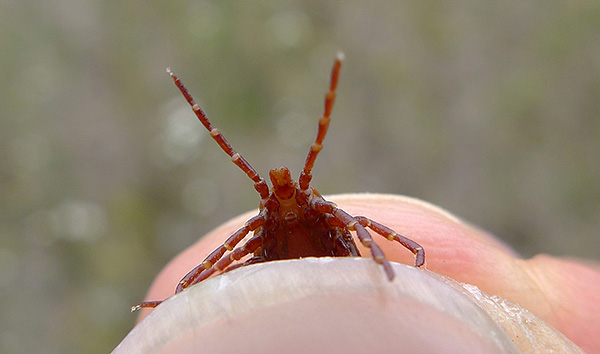
Adult individuals have differences in morphology, depending on gender — females have only a small shield on the back, and in males the shield covers the entire back. This is due to the fact that females feed much more intensively, and a large shield - a solid chitinous formation - will interfere with the stretching of the body during blood suction.
On a note
It is worth noting that stretching occurs due to a special cuticle that completely covers the body of the tick. In a hungry individual, this cuticle contains a multitude of microspaces and grooves, which flatten out during saturation, and the body increases, acquiring a rounded shape and a grayish tint.The color of a hungry tick can vary from yellow-brown to almost black.
The mouth apparatus of ixodic ticks is ideally suited for feeding blood on the hosts with dense integuments of the body. It consists of a base, a proboscis, one pair of chelicerae enclosed in cases, and a pair of palp. The base of the proboscis is a capsule with a dense chitinous cover, where the ducts of the salivary glands are located. Palpi consist of 4 segments and perform a tactile function.
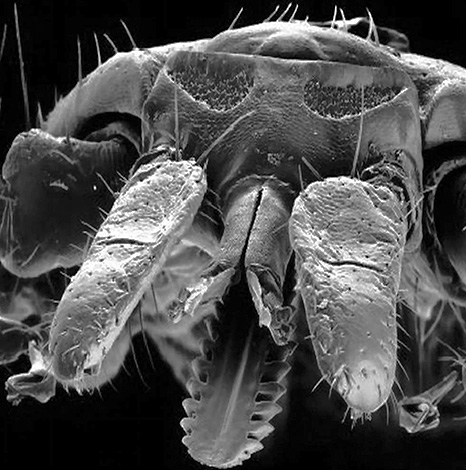
A hypostome or proboscis is a rigid chitinous plate fixedly attached to the base. On it are rows of sharp, hooked back hooks that help cut through the skin like a saw and fasten in it like a harpoon.

The victim usually does not even notice the bite process, because the parasite's saliva contains painkillers that act on the nerve endings almost immediately.
In addition to painkillers and anticoagulants of the blood, there is also a special protein secretion in the saliva of the tick, which hardens around the penetrated trunk. This provides additional reliability when fastening in the skin - a kind of "cement case".
Lifestyle and habitat
Ixodes are mainly pasture parasites waiting for their owners in the open nature. For life, they prefer mixed forests and meadows with high grass cover. The process of their “hunting” is usually passive - ticks almost never pursue potential victims intentionally, they simply wait for the right moment to catch on wool or clothing.

Ixodes ticks are generally very slow - in their entire life each individual passes no more than a couple of tens of meters.
At each stage of development, the parasite needs to be fed only once, therefore, having satiated on the host, it disappears, and only in some cases it can remain on the host’s body to move to the next age. Ticks overwinter mainly in forest litter, sometimes in burrows of their owners or even on their own.
Species that have adapted to a specific burrow of parasitism are often much easier to cope with the search for food - after all, the sources of blood are almost always nearby. Such, for example, is the tick Ixodes laguri, which lives in burrows of rodents.
It is interesting
In certain cases, strict specificity in the choice of the victim severely limits the rhythm of life of the tick itself.For example, Ixodes uriae, adapted to living in rock crevices in bird markets, can eat only during bird nesting, and during the rest of the year they starve. Due to the geography of its habitat, this species parasitizes even on penguins.

Ixodide distribution
Ixodes are common everywhere, and are found on all continents of the globe. But, as for any organisms, for them there are their own limiting factors. First of all, it is the need for optimal temperature and humidity. Even in the same forest in different parts of it, an unequal microclimate predominates. In meadows open to sunlight, there may not be enough moisture for normal ticks. And, for example, on the edge of the forest or in more often there may be plenty of water. Therefore, the distribution of ixodide in any geographical area is intermittent, mosaic.
The presence of suitable hosts is also important, but the Ixodes are highly plastic, and therefore are often able to survive almost everywhere where terrestrial vertebrates live.

Altitude is also not a serious restriction for ticks: they are found in all altitudinal zones - from sea level to highlands. For example, Ixodes acutitarsus is often found in the Himalayas above forest level.
However, the greatest diversity of Ixodes ticks is observed in subtropical and tropical latitudes. The further away from them, the fewer types of Ixodides can be found.
One of the most famous ticks, the taiga, has a distribution within the boundaries of the area bounded by Kamchatka and Sakhalin from the north, and the Moscow Region from the south. His relative dog tick is found in North Africa and throughout Europe, reaching the Volga. The brown dog tick, as already mentioned, prefers coastal areas, including the Crimea and the Caucasus. It is these species that represent the greatest epidemiological danger for the residents of Russia and European countries.
The owners of different types of ticks
In the life cycle of ixodide there are three active stages - the larva, the nymph and the imago, and at each stage the tick feeds only once. Some species attack the new host at each stage. Such, for example, are the taiga and dog ticks - the spectrum of the types of their victims depends on the stage of development of the parasite itself.
Larvae and nymphs feed on rodents and birds, while adults prefer large mammals, including humans. Such species are called three-owner, because at each of the three stages of development the parasite must find a new animal.
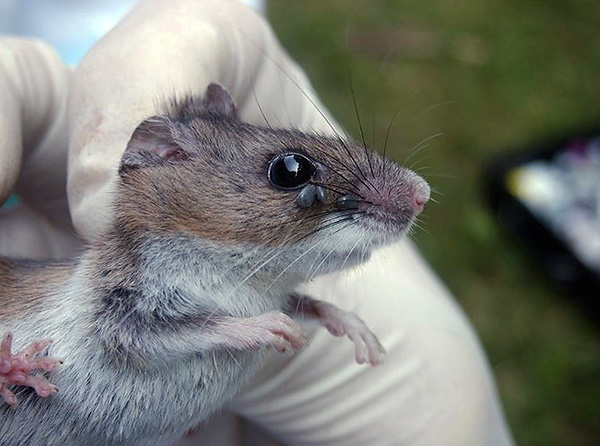
There are also dwelling mites - this means that the larva, sucking blood, does not leave its first owner. Transformed into a nymph, she bites him again, and only after that does she fall away from the first victim. For the third time, an adult tick will bite another animal.
Hyalomma marginatum is a typical example of such a parasite: the larva, and then the nymph feed on the first host (rodent or bird), and after molting and turning into imago - already on the second, which can be either a cow or a horse, or a man.
In single-owner parasites, the tick will not leave its first and only host until it reaches the adult stage. An example of this is the Mediterranean species Boophilus calculator, which is also widespread in southern Ukraine. The larvae attack the animal (usually a large mammal), and go through all further stages of development right on it. The females' already drunk with their blood are leaving the host in order to lay several thousand eggs on the ground. This feature allows you to increase the survival rate of the species, because there is no need to wait three times to meet with a potential victim.
Interesting fact
There are among the Ixodides and species with a narrow specialization - feeding only on birds, reptiles or mammals. For example, the tick Hyalomma aegiptium at all phases of growth prefers only land turtles as hosts. But Amblyomma sphenodonti is a unique look in several ways at once. Firstly, it lives exclusively in New Zealand, and, secondly, it feeds only on the tuatres - the oldest form of reptiles, “living minerals” of modern times. One can only imagine how many thousands of years such a close relationship of hosts and parasites lasts. In the photo below you can see the mites between the scales of the guitar:
The duration of the nutritional period of the tick increases with each subsequent stage of development. Larvae can attach to their hosts for 3-5 days, nymphs - 3-8, and adults fill with blood up to 10-12 days. At the same time, the effect of mites on an animal depends on many factors: the susceptibility of the host, its mass and the overall degree of infection.
Often, a severe tick-borne infection leads to a massive loss of livestock. For example, 3-4 female ticks per 1 kg of the body of an ordinary sheep are already a threat of an imminent death.
If there are too many ticks on the animal, it results in large blood loss and acute intoxication with saliva. Ixodide saliva contains many proteins that can cause the hardest immunological reactions. In addition, tissue damage in the area of the bite can result in suppuration and additional infection, not to mention diseases that can be transmitted by the mites themselves.
Nutrition specifics
Before you start to suck blood, the tick usually takes a long time to find a suitable place on the host's body. He will definitely prefer the area with delicate thin skin, so often ticks are found on the neck, behind the ears, in the groin area, on the folds of the limbs.
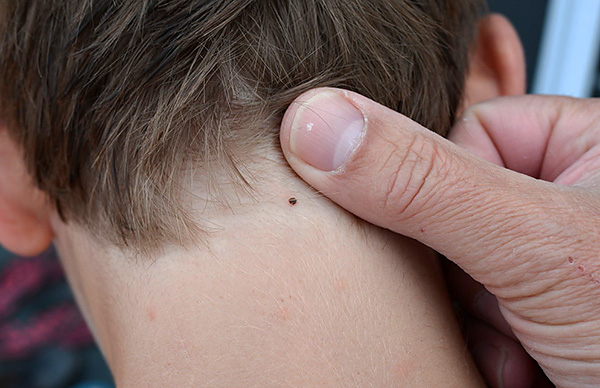
Having found a successful zone for a bite, the parasite rests against the front of the body into the skin and assumes a position almost perpendicular to it, sticking the chelicerae. This process is not instantaneous, and the self-procuring of the host's covers can take several tens of minutes. Gradually, chelicerae are introduced deeper and pushing the wound from the inside, allowing the proboscis to penetrate the skin. Inside the proboscis there is a pre-oral cavity, where the salivary glands exit, and the saliva is actively secreted into the wound area.

If the tick is infected with any infection, then at this moment the pathogens will begin to penetrate into the host tissue.
The special protein component - the secret of saliva - quickly hardens, creating an intermediate “cemented” zone between the proboscis and the host tissues, additionally fixing the oral apparatus of the tick in the skin. At the end of the “cement case” multiple hemorrhages and an inflammatory focus are formed, but the parasite's saliva also contains anesthetics, and therefore the bite often goes unnoticed.
In addition, saliva contains vasodilators and components that prevent blood clotting (anticoagulants). All this is necessary to ensure successful long-term feeding of the tick.
An interesting fact is that sucking is not a continuous act of food ingestion in the parasite. In the process of nasazyvaniya blood alternate active stage of saturation and rest. In the pre-oral cavity of the tick, thanks to the musculature of the pharynx, a vacuum is created that acts as a pump for the blood and lymph during their absorption. Having got drunk, the tick gets a proboscis from a body and disappears.

On a note
Ixodide has several amazing features of biology, which are characteristic only for some representatives.One of them - aphagia - is a phenomenon in which adult males of certain species do not feed at all, but are engaged only in the fertilization of fed females, after which they immediately die.
Another interesting phenomenon characteristic only for ticks is omovampirism, in which hungry ticks (usually males) do not hesitate to attack their well-fed relatives. They pierce the body of a fellow and suck some of the blood out of it. What is remarkable: the tick-victim remains alive after such an unceremonious interference with its metabolic processes, and if it is a female, then she is quite capable of safely laying eggs after this.
Reproduction and development
It is not easy to give a general characteristic for all ixodides in terms of reproduction and development. They are characterized by a huge variety of life cycles for the total duration and seasonal activity of hungry individuals. All three active stages can develop in one warm season, sometimes even several generations form during this time. In other cases, the transition from an egg to a larva, a nymph, and then an imago takes a long time, and the cycle stretches for up to five years.
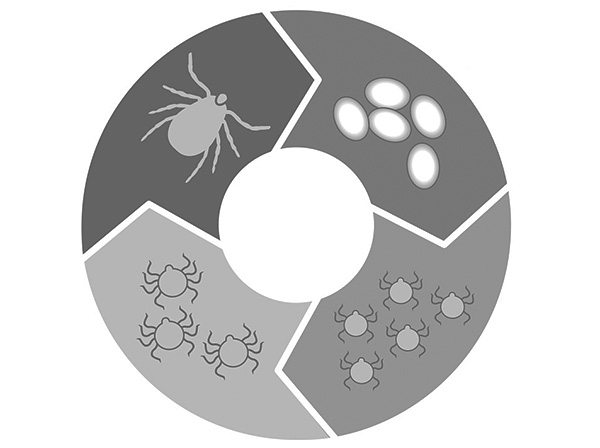
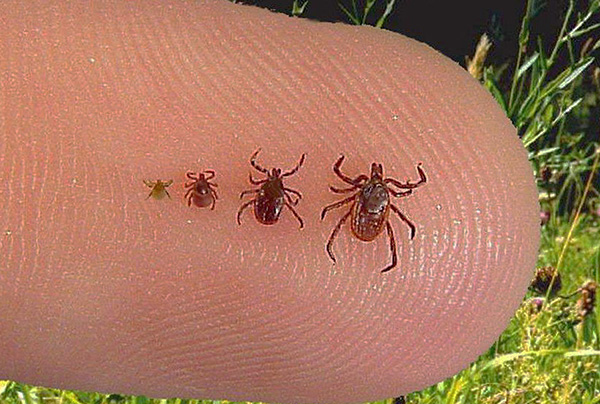
The total duration of bloodsucking on the host for the entire life of an Ixodes tick reaches an aggregate of about 15 days, which is an extremely small fraction of the total duration of ontogenesis. But during this time, serious qualitative changes occur in the body of the tick, associated not only with stretching of the integuments of the body during feeding, but also with the development of its organism as a whole. Due to this, after saturation, the larva becomes a nymph, and that, in turn, is an adult.
As already mentioned, mites attack animals of different sizes at different stages of development. If in the first two stages small rodents, reptiles and birds become victims of the majority of ixodides, adults are preferred by large animals, including ungulates and humans.
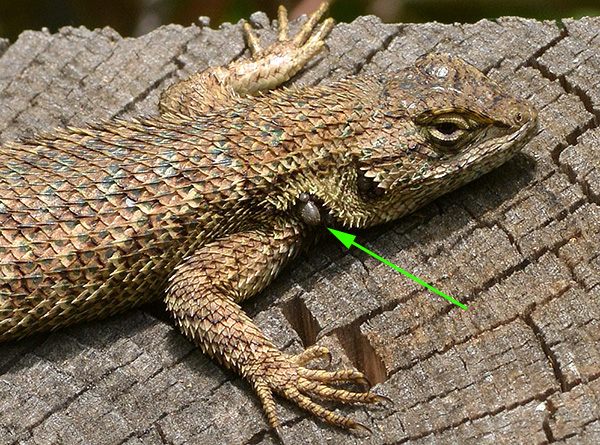
Depending on how many owners change the tick over their lives, the types of parasitism and the proportion of surviving individuals differ. Trilatory mites survive worse than double-stranded and single-stalked mites because they are forced to leave the previous victim after each feeding event, and it is often very difficult to find the next one. Therefore, at the larval and nymph stage, such ixodides perish en masse. Although this does not apply to breeding and burrowing parasites, which actually share a home with their owners, and are more likely to be provided with food.
Reproduction of ixodic ticks is also not without interesting details. The search for a partner and the mating itself most often takes place directly on the host. This is explained by the fact that the search for each other in nature is extremely difficult due to the solitary lifestyle, wide habitat area and low mobility.
In addition, individuals of some species are generally incapable of mating without being saturated with blood. Therefore, the ideal place for a "date" - just for the meal. On the 3-5th day of bloodsucking, adult ixodide females begin to secrete special compounds - pheromones, which attract the males.
The pairing is carried out directly while feeding the female, which she does not interrupt for several days after insemination. The male either dies immediately after mating, or may consume another portion of blood and go looking for a new female.
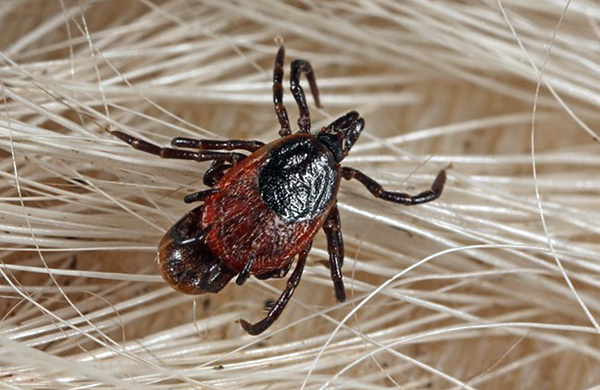
By the way, nutrition of ticks differs depending on gender. In general, for all Ixodes, a much shorter sucking of males to the host is typical compared with females - they only need a couple of hours to saturate.And the male body itself is not adapted for large volumes of blood - it is surrounded on all sides by rigid inextensible scutes.
After the fertilized female is fed with enough blood, she disappears from the host and prepares for the process of laying eggs. Their maturation takes from several days to a month, and is due to nutrients derived from the blood of the last victim.
The laying process itself is also long - from three weeks to two months. In this case, the female dog mite will lay an average of 2000-3000 thousand eggs, but individuals of more exotic tropical species - up to 20 thousand eggs, and sometimes even 30 thousand or more.

How dangerous are these parasites?
Ixodid ticks are dangerous, first of all, as carriers of many infectious diseases, and therefore have important medical significance. For a variety of transmitted infections, they are ahead of all arthropods, including mosquitoes.
About 100 viruses, 200 types of piroplasmid, dozens of rickettsia, trypanosomes and bacteria were isolated from ticks collected in nature. But still, infection with one or other infections is not the norm for ixodides - ticks become infected with them either when feeding on a sick animal, or else in an egg from an infected maternal individual.
With rare exceptions, the breeding pathogen does not do any harm to the tick, unlike its possible host.
The most common and significant infections carried by ticks are:
- Tick-borne encephalitis is one of the most dangerous diseases, often ending in death. Caused by a virus that actively reproduces in the cells of the nervous system, causing its severe damage, even paralysis. There are several subtypes of this infection, and some of them are easier, while others are very difficult and with complications;
- Lyme borreliosis - a bacterial disease. Symptoms are very diverse: fever, pain in the head, fatigue, nausea. A characteristic sign is ring-shaped redness around the tick bite (erythema migrans). If you do not cure the disease at the initial stage, severe lesions of the brain, cardiovascular system and joints with a possible fatal outcome join the symptoms;
- Tick-borne typhus is a disease caused by rickettsia. They multiply in the vascular endothelium, causing an inflammatory reaction in the body. This process is accompanied by high fever, rash (first on the limbs, and then all over the body), swelling of the face, an increase in lymph nodes. More often ends with complete recovery;
- Pyroplasmosis - rarely transmitted to humans, but very dangerous for pets. Called piroplasma - parasites that destroy the red blood cells. The disease begins acutely, with a sharp increase in temperature, the animal stops eating and drinking, more often lies. In the absence of proper treatment in less than a week, death occurs.
The photo below shows erythema migrans - a characteristic sign of Lyme disease:
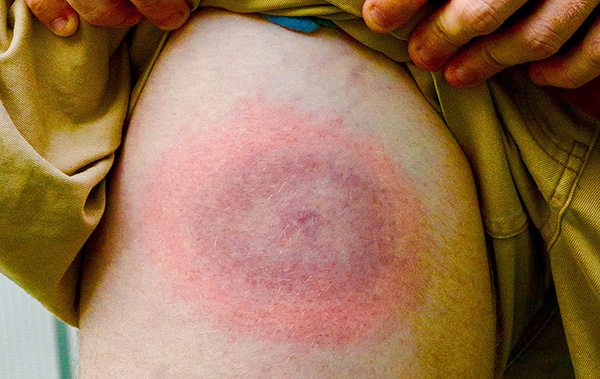
It is important to note that even uninfected ticks with a large number of them on one host cause him enormous harm. Ixodide wounds from penetration of proboscis may additionally be infected with pathogens from the skin or air. Such damages can then fester and not heal for a long time, causing severe discomfort. With an impressive amount of sucking ticks, the host also begins to suffer from blood loss. This represents a danger of developing anemia that is incompatible with life.
Ways to protect against ticks and fight against them
There are several effective ways to protect against the bites of ticks on nature. The simplest thing to do is to dress properly when going to a potentially dangerous area.Shirts with a high collar and long sleeves with tight cuffs, long trousers and, if possible, closed high shoes are suitable for this.
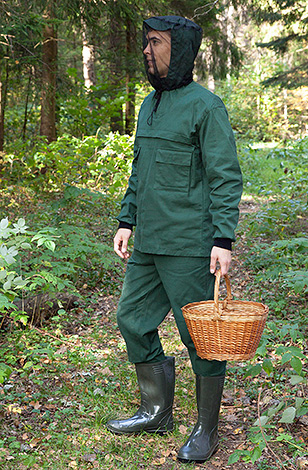
It is advisable to fill the pants with socks and the shirt into the pants. It is also good to use smooth and light fabrics in clothes, for which the tick is more difficult to catch and on which dark ticks are clearly visible.
Among the active control measures, the sprinkling of clothing and animal hair with repellents containing diethyltoluamide (DETA), dimethylphthalate, repudin, diethylphthalate, carboxyl, repectal and others is effective. For animals, there are also tablets and injections that provide resistance to tick bites for a certain time.
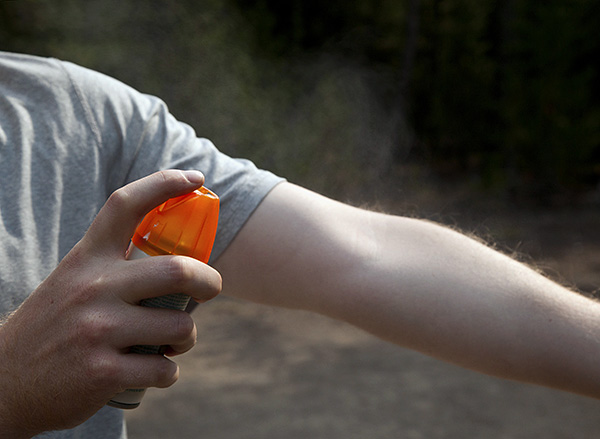
Self-made protective sprays are popular among folk remedies. They are made from natural essential oils, vinegar or ointments with strong odors, mixing them with water. Perhaps they have some effect, but a person needs to be ready to suffer the annoying smell of the remedy, which is not for everyone. In any case, the strength of the protective action of such drugs is in the majority inferior to those based on powerful synthetic repellents.
Upon returning from a park or forest, it is useful to carry out self-examination or mutual examination for the presence of ticks - this way you can quickly get rid of parasites that have not yet had time to stick to the skin. If the tick was found already attached, then it is necessary to remove it with tweezers or with fingers wrapped in gauze. Remove the parasite with light rotational movements, trying not to tear the body from the head and not crush the tick itself.
It is important not to try to pull the tick out with a simple tearing movement - in this case, you can tear off its body from the head, which will remain in the skin and lead to suppuration.
In regions where cases of tick-borne encephalitis have been repeatedly recorded, there is a well-established system for the prevention of this disease. It includes both vaccinations and emergency help immediately after being bitten by an infected tick.
If desired, you can take a course of vaccination from several vaccinations, following one after the other in a strict time ratio. This course provides reliable protection against the disease, but the vaccination must be periodically repeated, because the immunity to encephalitis after it lasts only about a year.

If a tick infected with a tick-borne encephalitis virus has already bitten, and the person has not been vaccinated before, then an emergency injection of anti-encephalitic gamma globulin will be effective for the first three to four days. This protein binds specifically to the pathogen and prevents the disease from developing.
Garden plots can be expediently processed to kill ticks on them. To combat ixodides, special acaricides are used - in large areas they are sprayed with the help of aviation, and in small areas - with hand and motor dispensers.
On a note
Previously, long-acting drugs such as DDT (dichlorodiphenyltrichloroethane) and HCH (hexachlorocyclohexane) were widely used as agents for treating the area. They showed high efficiency in the destruction of ticks, but also proved to be dangerous to the environment and the people themselves.
Today, to get rid of ticks in the territories of sanatoriums, recreation centers and children's camps, safer drugs are used: karbofos, trichlorvos, chlorpyrifos, fenthion, permethrin, cypermethrin and others. It is preferable to poison ticks by the forces of professional disinsectors - they have access to modern effective drugs and know how to apply them correctly.
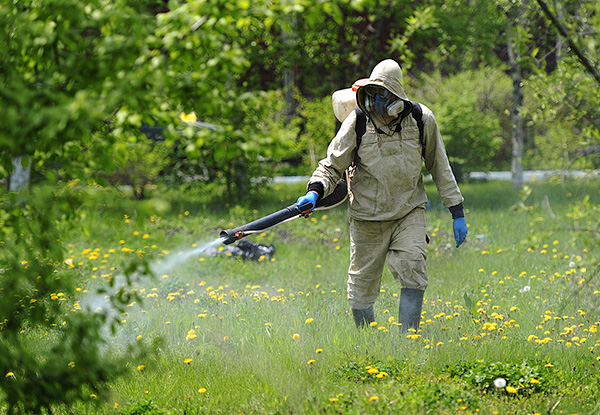
The control over the number of ticks is also supported by their natural enemies in nature. Here ixodides often feed on predators, the diversity of which is quite large: spiders, beetles, ants, wasps, and centipedes. They are eaten by amphibians, reptiles and birds, and the latter can even eat wintering ticks in their hiding places. That is why the site is useful not only to process acaricides, but also to make ticks attractive to natural enemies.
Interesting video: curious facts about Ixodes ticks ...
Test the effectiveness of various means of protection against ticks

